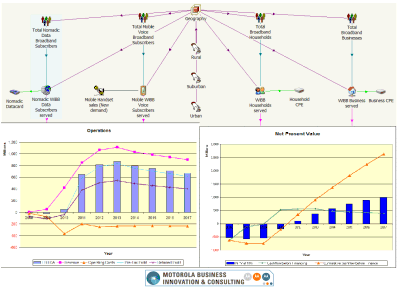 Motorola’s Business Innovation and Consulting (BIC) group has been successfully using STEM
to support the strategic analysis of Motorola’s technology, market and business
opportunities. The group is part of the global Strategy and Business Development
organisation of Motorola’s Networks and Enterprise business, whose 2006 revenues
exceeded USD11 billion. Part of the BIC team’s remit is to be responsible for the
techno-economic analysis of Networks and Enterprise’s strategies, mergers and acquisition
opportunities, undertaking business modelling and business simulation as well as
providing internal consultancy and business advisory services.
Motorola’s Business Innovation and Consulting (BIC) group has been successfully using STEM
to support the strategic analysis of Motorola’s technology, market and business
opportunities. The group is part of the global Strategy and Business Development
organisation of Motorola’s Networks and Enterprise business, whose 2006 revenues
exceeded USD11 billion. Part of the BIC team’s remit is to be responsible for the
techno-economic analysis of Networks and Enterprise’s strategies, mergers and acquisition
opportunities, undertaking business modelling and business simulation as well as
providing internal consultancy and business advisory services.
“We have been using STEM for a little over two years, originally purchasing it to
support the enhancement of Motorola’s techno-economic capabilities, and in response
to our customers’ requirements to provide guidance on technologies and strategies,”
said David McGrath, Senior Director and leader of the BIC group.
The decision to purchase STEM was based on the need to reduce the cycle times in
creating business models and strategic analysis; the requirement to re-use business
modules; STEM’s ability to link to Excel for input parameters and to export results;
the ease with which models can be distributed and controlled; plus the capability
to link to other technical and business simulation tools.
“We use STEM as a complement to Excel, not as a complete replacement, finding STEM’s
scenario-building abilities very powerful to answer the ‘what if?’ questions which
are always an integral part of our strategic analysis.”
As with any powerful application, there was a lot to learn, but as Mark Atkins,
BIC Director, commented: “Once you have gone through the learning curve, STEM becomes
an easy and useful tool enabling you to create models in a very quick time frame.”
BIC has now successfully developed a number of models in STEM, ranging from models
exploring strategic positioning, business economics and acquisition models, through
to operator business models for comparison of technologies and deployment strategies.
BIC has used STEM to model technologies including Mobile WiMAX, HSDPA/UPA, CDMA
rev.A, MVNO, and LTE.

“Currently we are leveraging the business-model distribution capability of D-STEM,
to push a number of mobile operator technology business models out to our regional
experts and accounts teams, so that they can use them directly with our customers.
D-STEM supports this nicely with its distributed run-time models, and also provides
control over access levels within the model, helping to protect intellectual property.
This is being supported by high-level training on D-STEM for our subject
experts.”
“We are very happy with the extended business modelling and analysis capabilities
which STEM has enabled,” said Mr McGrath. “Each year we continue to push and enhance
the business modelling and simulation environment, and its added value for Motorola.
This year we are examining the linkage between STEM and other systems dynamics,
market modelling, technology and business simulation tools.”
“As we link and enhance these various tools, we are creating a powerful portfolio
of tools and techniques to achieve the objectives of the BIC group. We are deepening
our understanding and insights, and developing techno-economic leadership to guide
the strategies of Networks and Enterprise. Our aim is to enhance Motorola’s ability
to deliver viable and impactful business solutions to our customers, while creating
profitable growth.”
 David
McGrath is a Senior Director in Motorola’s Strategy and Business Development organisation,
and leads the BIC group, where he focuses on the business strategy and techno-economics
of mobile, enterprise and public safety communication networks, as well as business
innovation.
David
McGrath is a Senior Director in Motorola’s Strategy and Business Development organisation,
and leads the BIC group, where he focuses on the business strategy and techno-economics
of mobile, enterprise and public safety communication networks, as well as business
innovation.
David is also a member of the International Technology Industry advisory board to
the UK and Australian governments. He is based in London, and has 20+ years of experience
in the international communications and high-tech industries, including three business
start-ups (Internet, Voice and Mobile). He holds a first degree in Electrical Engineering
(Computing and Communications), a Masters in Computer Science and an MBA from London
Business School.
Motorola provides seamless
mobility products and solutions across broadband, embedded systems and wireless
communications networks worldwide.